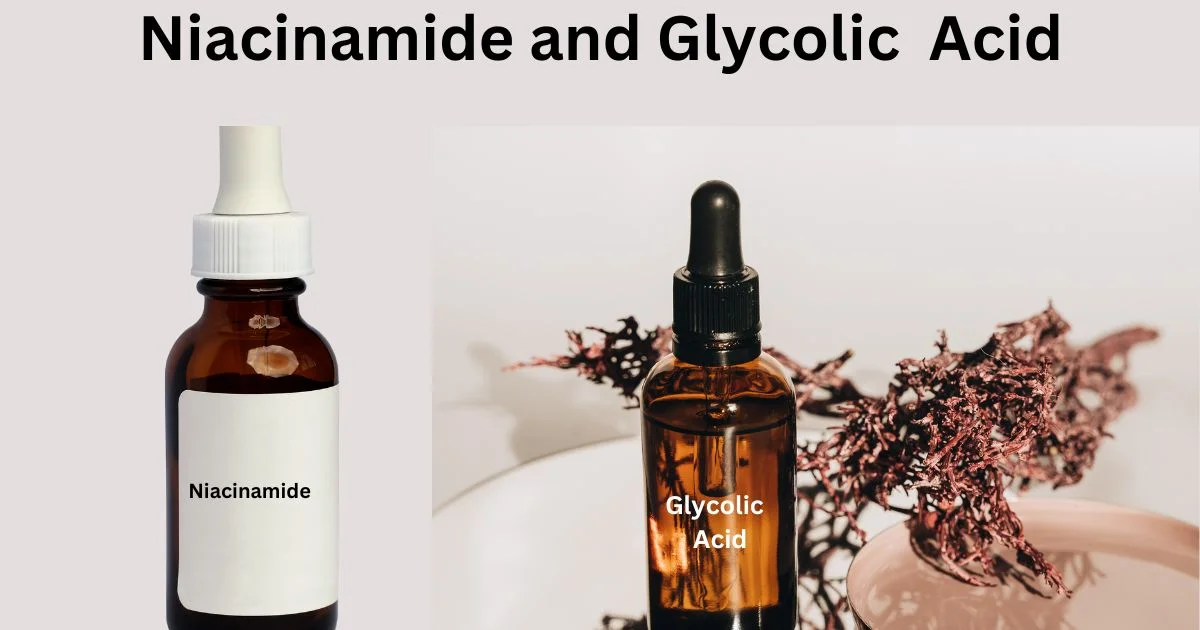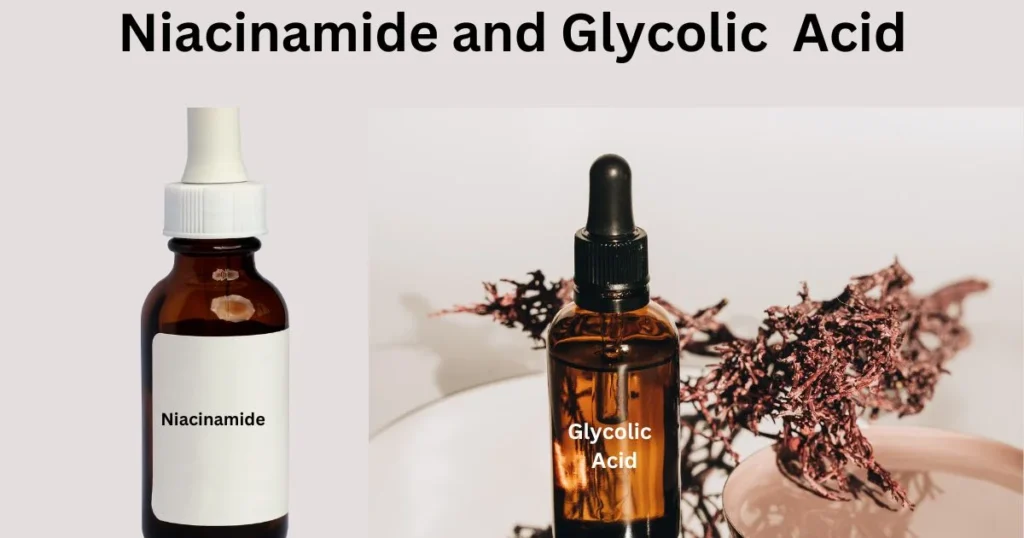Niacinamide and Glycolic Acid: The Power Duo for Skin Care
Niacinamide and glycolic acid are two prominent skincare ingredients known for their remarkable benefits in achieving healthier and more radiant skin. Niacinamide, a form of vitamin B3, helps improve the skin’s overall texture, minimize the appearance of pores, and regulate sebum production. It also aids in reducing hyperpigmentation and boosting the skin’s natural barrier.
Glycolic acid, an alpha-hydroxy acid (AHA), acts as a powerful exfoliant, gently removing dead skin cells and promoting cell turnover. This results in a smoother complexion, improved skin tone, and diminished fine lines and wrinkles. When combined, niacinamide and glycolic acid create a dynamic duo that tackles various skin concerns, making them sought-after ingredients in skincare routines. In this article We will explore how these ingredients work individually and synergistically, and provide you with valuable insights to help you achieve radiant and youthful-looking skin.
 Niacinamide and Glycolic Acid: Explained
Niacinamide and Glycolic Acid: Explained
What is Niacinamide?
Niacinamide, also known as Vitamin B3, is a water-soluble vitamin that offers a multitude of benefits for the skin. It is a key player in various cellular processes and acts as a precursor to essential coenzymes involved in energy production. Niacinamide is a versatile ingredient with potent antioxidant, anti-inflammatory, and skin-barrier strengthening properties. When incorporated into your skincare routine, niacinamide can help address a wide range of skin concerns and promote overall skin health.
You may also like..Can Niacinamide and Salicylic Acid be used together? 10 Powerful benefits The Ordinary Glycolic Acid 7 Toning Solution Glycolic Acid and Vitamin C for Radiant Skin Retinol and Vitamin C: Unlocking the Secrets to Youthful Skin
What is Glycolic Acid?
Glycolic acid is a type of alpha hydroxy acid (AHA) derived from sugarcane. With its small molecular size, glycolic acid easily penetrates the skin and provides numerous skin-enhancing benefits. This remarkable ingredient exfoliates the skin by removing dead cells and impurities, revealing a fresher and brighter complexion. It stimulates collagen production, improves skin texture, and helps fade hyperpigmentation, making it a go-to ingredient for those seeking smoother, more youthful skin.
The Benefits of Niacinamide and Glycolic Acid
1. Reduced Hyperpigmentation
One of the most sought-after benefits of the niacinamide and glycolic acid combination is their ability to reduce hyperpigmentation. Niacinamide helps inhibit the transfer of melanin within the skin, effectively minimizing the appearance of dark spots and uneven skin tone. Glycolic acid, on the other hand, accelerates cellular turnover, allowing fresh and evenly pigmented skin to surface. Together, they work harmoniously to fade existing hyperpigmentation and prevent new spots from forming.
2. Enhanced Skin Moisture
Niacinamide is a true hydrating powerhouse. By strengthening the skin’s natural moisture barrier, it prevents water loss and keeps the skin adequately hydrated throughout the day. Glycolic acid complements this action by gently exfoliating the skin’s surface, allowing better absorption of moisturizers and serums. The combination of niacinamide and glycolic acid ensures your skin stays plump, supple, and well-nourished.
3. Improved Skin Texture
Uneven skin texture can be a frustrating issue for many individuals. However, the regular use of niacinamide and glycolic acid can help refine and smoothen the skin’s surface. Niacinamide promotes the production of ceramides, fatty acids that maintain a healthy skin barrier and enhance overall texture. Glycolic acid’s exfoliating properties further aid in reducing roughness, fine lines, and acne scarring, leaving you with a visibly smoother and more youthful complexion.
4. Minimized Pores and Acne Control
Large pores and acne-prone skin can significantly impact self-confidence. Niacinamide possesses sebum-regulating properties, which help control oil production and minimize the appearance of pores. By keeping excess sebum in check, niacinamide reduces the likelihood of clogged pores and acne breakouts. Glycolic acid’s exfoliating effects further assist in unclogging pores, preventing the formation of blackheads and whiteheads. The combined action of these ingredients results in clearer, more refined skin.
5. Anti-Aging Effects
As we age, the signs of aging become more apparent on our skin. Niacinamide and glycolic acid work synergistically to combat these signs and promote a more youthful complexion. Niacinamide enhances collagen production, which helps improve skin elasticity and reduce the appearance of fine lines and wrinkles. Glycolic acid’s exfoliation encourages the growth of new, healthy skin cells, further reducing the visibility of age-related concerns.
Using Niacinamide and Glycolic Acid: A Step-by-Step Guide
- Cleanse your face thoroughly with a gentle cleanser to remove any dirt, oil, and impurities.
- Pat your skin dry with a clean towel, ensuring it is completely dry before proceeding.
- If you’re using a toner, apply it to your face using a cotton pad to further cleanse and balance your skin.
- Start with the niacinamide product. Take a small amount and gently massage it onto your face, avoiding the delicate eye area. Allow it to absorb fully into the skin.
- Next, apply your glycolic acid product. Start with a lower concentration and gradually increase as your skin becomes more accustomed to it. Apply a thin layer to your face, focusing on areas of concern such as hyperpigmentation or uneven texture.
- Allow the glycolic acid to penetrate the skin for a few minutes. If it’s your first time using it, begin with a shorter duration and gradually increase the exposure time.
- Follow up with the rest of your skincare routine, such as moisturizer, sunscreen (especially if using glycolic acid in the morning), and any other preferred products.
- Remember to use sunscreen with a high SPF during the day as glycolic acid can increase sun sensitivity.
- Start by using these products two to three times a week and gradually increase the frequency as your skin tolerates it. Pay attention to how your skin reacts and adjust accordingly.
- If you experience any irritation, redness, or discomfort, reduce the frequency of use or discontinue use altogether. It’s always best to consult with a dermatologist if you have any concerns.
Note: It’s essential to patch test new products containing niacinamide and glycolic acid before applying them to your entire face, especially if you have sensitive skin.
Risks of mixing niacinamide with glycolic acid:
While both niacinamide and glycolic acid offer numerous skincare benefits individually, it’s important to be aware of potential risks when combining them in a skincare routine:
- pH Interaction: Glycolic acid is an exfoliating AHA that works best at a low pH, while niacinamide performs optimally at a slightly higher pH. Mixing the two ingredients directly may alter the pH balance and reduce their effectiveness.
- Skin Irritation: Combining these potent ingredients may increase the risk of skin irritation, especially for those with sensitive or reactive skin. This can lead to redness, dryness, or even mild to moderate burning sensations.
- Compromised Barrier Function: Excessive or improper use of niacinamide and glycolic acid can compromise the skin’s protective barrier, causing increased sensitivity, inflammation, and potential moisture loss.
- Uneven Results: Mixing niacinamide and glycolic acid may yield unpredictable results, as their simultaneous use might interfere with each other’s efficacy and potential benefits.
Conclusion
In conclusion, incorporating niacinamide and glycolic acid into your skincare routine can provide remarkable benefits for your skin. From reducing hyperpigmentation and improving skin texture to controlling acne and enhancing overall skin health, this power duo has gained recognition for its effectiveness. However, it is crucial to remember that skincare is a personal journey, and what works for one person may not work for another. It’s always wise to listen to your skin, start with lower concentrations, and consult with a skincare professional for personalized advice. With proper usage and consistency, niacinamide and glycolic acid can contribute to achieving a radiant, youthful complexion. Embrace the journey to healthier skin and enjoy the transformative effects of this dynamic duo.
Disclaimer: The information provided in this article is for educational and informational purposes only and should not be considered as professional advice. Readers are advised to consult with a qualified skincare professional or dermatologist for personalized recommendations and guidance.
FAQs
Can niacinamide and glycolic acid be used together?
Absolutely! Niacinamide and glycolic acid can be used together in your skincare routine. However, it is advisable to introduce them gradually and observe how your skin responds. Start with a lower concentration of each ingredient and gradually increase as your skin acclimates. It's also essential to use a broad-spectrum sunscreen during the day when incorporating these ingredients, as they can increase sun sensitivity.
How often should I use products with niacinamide and glycolic acid?
The frequency of use depends on your skin's tolerance and the specific products you are using. For most individuals, incorporating niacinamide and glycolic acid products into their routine two to three times a week is a good starting point. However, it's always recommended to follow the instructions provided by the manufacturer and consult with a dermatologist for personalized advice.
Can niacinamide and glycolic acid cause skin irritation?
While niacinamide and glycolic acid are generally well-tolerated by most individuals, some people may experience mild irritation, especially when first introducing these ingredients. To minimize the risk of irritation, start with lower concentrations and gradually increase over time. If persistent irritation occurs, discontinue use and consult a dermatologist.
Can niacinamide and glycolic acid be used on sensitive skin?
Yes, niacinamide and glycolic acid can be used on sensitive skin. However, individuals with sensitive skin should exercise caution and perform a patch test before incorporating these ingredients into their routine. Start with lower concentrations and monitor your skin's reaction. If any irritation or discomfort occurs, discontinue use and consult a dermatologist.
Can niacinamide and glycolic acid be used in the morning or evening?
Niacinamide and glycolic acid can be used both in the morning and evening, depending on your personal preference and the rest of your skincare routine. However, it's important to note that glycolic acid can increase sun sensitivity, so if used in the morning, it should always be followed by a broad-spectrum sunscreen


 Niacinamide and Glycolic Acid: Explained
Niacinamide and Glycolic Acid: Explained

